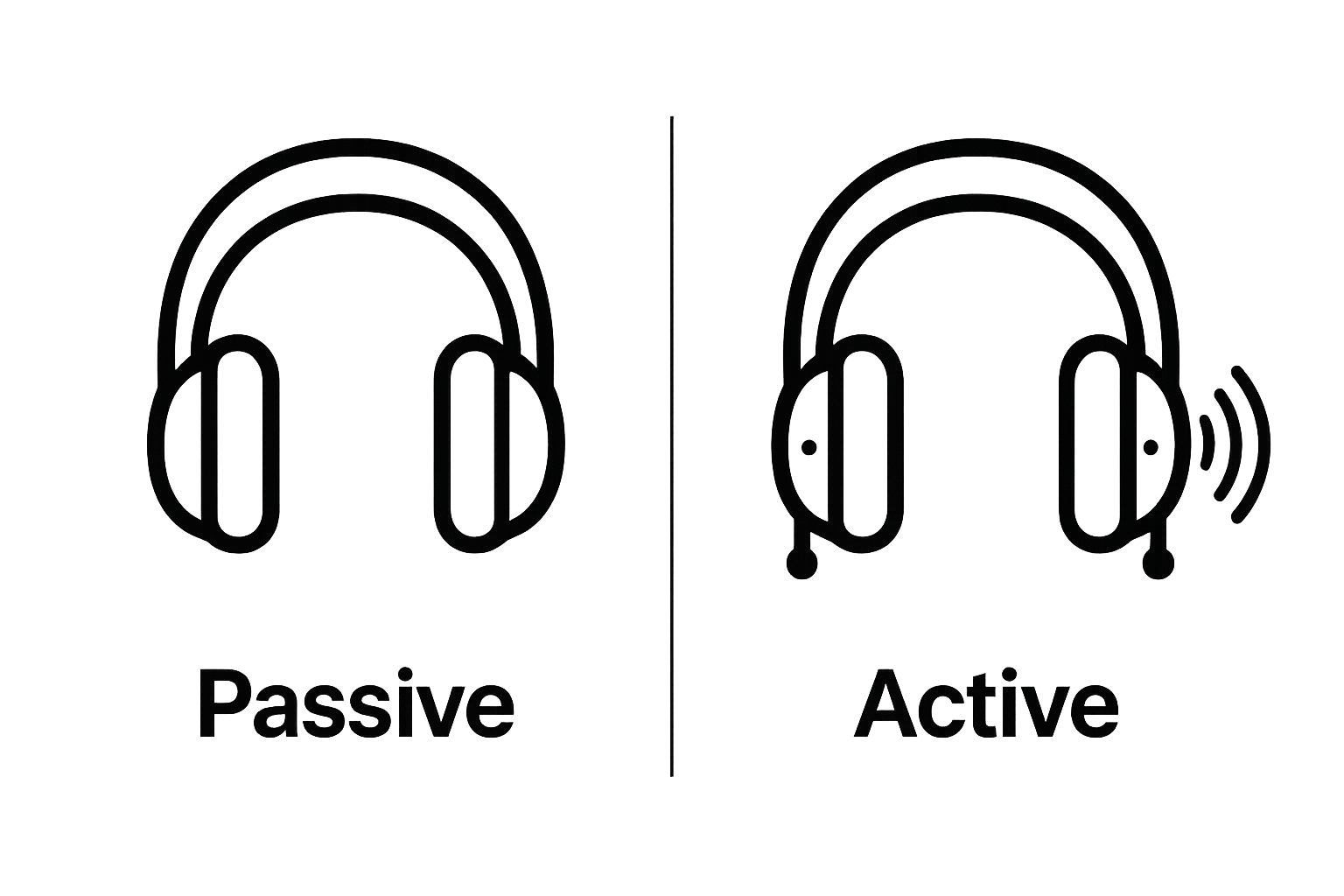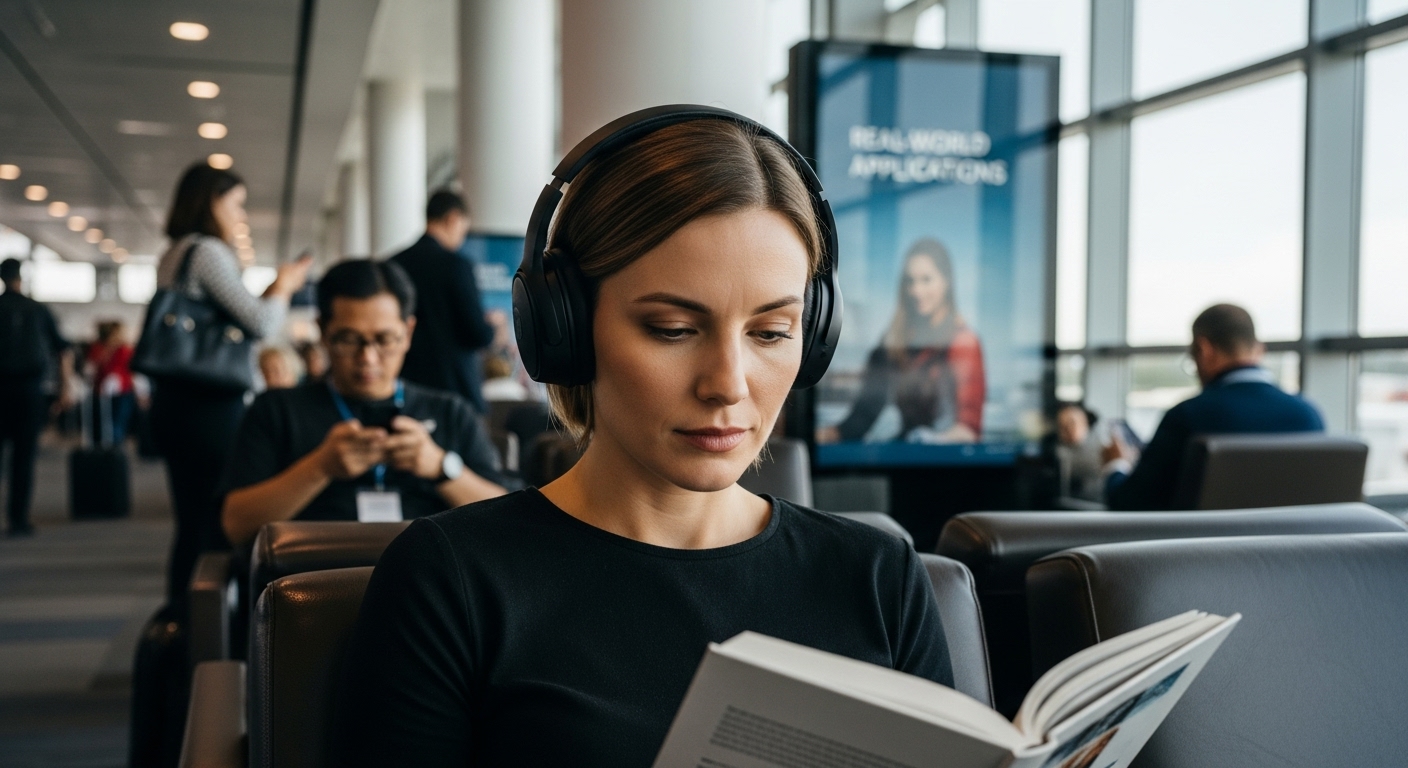Noise-canceling headphones promise total escape from the chaos, delivering sound so clear you can almost forget the outside world exists. Turns out most people have no idea that these devices use anti-noise waves generated in real time by microphones and processors to actually erase sounds before you hear them. People think they just block sound like ear muffs but the truth is they use cutting-edge science to literally rewrite your listening experience on the fly.
Table of Contents
- What Are Noise-Canceling Headphones And Their Purpose
- The Science Behind Noise-Canceling Technology
- Types Of Noise-Canceling Headphones And Their Functions
- Benefits Of Using Noise-Canceling Headphones
- Real-World Applications Of Noise-Canceling Headphones
Quick Summary
| Takeaway | Explanation |
|---|---|
| Noise-canceling headphones enhance focus in noisy environments | These devices provide quiet spaces, boosting concentration during tasks in noisy places like offices or public transport. |
| Active noise control utilizes wave interference | They generate opposite sound waves to cancel ambient noise, effectively creating a serene listening environment. |
| Real-time filtering enables selective sound management | Emerging technologies allow users to filter specific sounds, improving audio experiences and communication clarity. |
| Health benefits include stress reduction | By minimizing distracting sounds, they help lower stress levels and promote a calmer mental state. |
| Noise-canceling headphones improve overall productivity | These headphones facilitate better focus, learning retention, and potentially protect hearing by allowing lower audio volumes. |
What Are Noise-Canceling Headphones and Their Purpose
Noise-canceling headphones represent an innovative audio technology designed to significantly reduce or eliminate unwanted ambient sounds, allowing users to experience superior sound quality and concentration. Unlike traditional headphones that merely cover your ears, these advanced devices actively block external noise through sophisticated electronic processing.
How Noise-Canceling Technology Works
At the core of noise-canceling headphones is a remarkable mechanism called active noise control. These devices use specialized microphones positioned on the ear cups to detect incoming sound waves from the surrounding environment. Once detected, the headphones generate an “anti-noise” sound wave that is precisely the opposite frequency of the ambient noise. When these sound waves meet, they effectively cancel each other out, creating a remarkably quiet listening environment.
Key components enabling this technology include:
- External microphones that continuously monitor environmental sounds
- Electronic processing units that generate inverse sound waves
- Advanced speaker systems capable of producing precise counter-frequencies
Practical Applications and Benefits
Noise-canceling headphones serve multiple purposes across various settings. According to research from the University of Washington, these devices are increasingly sophisticated, with emerging technologies even allowing users to selectively filter specific sounds in real-time.
Primary benefits include:
- Enhanced concentration in noisy environments like offices, airports, and public transportation
- Improved audio experience for music, podcasts, and professional audio work
- Potential stress reduction by minimizing auditory distractions
Whether you are a professional seeking focus, a traveler wanting peaceful journeys, or an audio enthusiast craving pure sound, noise-canceling headphones offer a transformative listening experience that goes far beyond traditional audio equipment.
The Science Behind Noise-Canceling Technology
Noise-canceling technology represents a sophisticated acoustic engineering approach that goes beyond simple sound blocking. It leverages complex electronic signals and wave interference principles to create a uniquely quiet listening environment, transforming how we experience sound in noisy environments.
Wave Interference and Sound Cancellation
The fundamental principle behind noise-canceling technology is destructive wave interference. Sound travels in waves with specific frequencies and amplitudes. When two sound waves with identical characteristics but opposite phases meet, they effectively neutralize each other. Noise-canceling headphones exploit this physical phenomenon by generating precise anti-noise waves that directly counteract ambient sound waves.
Key physical principles involved include:
- Phase reversal: Creating sound waves with exactly opposite frequencies
- Amplitude matching: Generating counter-waves with equivalent sound pressure
- Real-time signal processing: Continuously analyzing and responding to environmental noise
Electronic Signal Processing Mechanisms
Modern noise-canceling devices employ advanced digital signal processors that perform complex mathematical calculations in milliseconds. These processors continuously sample environmental sounds through dedicated microphones, analyze their frequency and amplitude, and instantaneously generate corresponding anti-noise signals.
According to research from the University of Washington, emerging technologies are now developing deep-learning algorithms that can selectively filter specific sound classes in real-time, representing a significant leap in noise-cancellation capabilities.
Significant technological components include:
- High-sensitivity external microphones
- Rapid digital signal processing units
- Precision audio reproduction speakers
The science behind noise-canceling technology demonstrates how understanding fundamental wave physics and leveraging advanced electronic engineering can create transformative audio experiences that dramatically reduce unwanted environmental noise.
Types of Noise-Canceling Headphones and Their Functions
Noise-canceling headphones are not a one-size-fits-all technology. They come in diverse configurations, each designed to address specific audio needs and user preferences. Understanding these variations helps consumers select the most appropriate device for their unique listening requirements.
Passive vs Active Noise-Canceling Designs
Two primary categories of noise-canceling headphones dominate the market: passive and active noise-canceling models. Passive noise-canceling headphones rely on physical sound blocking through dense materials and tight ear cup seals. These headphones create a physical barrier that reduces ambient noise by literally blocking sound waves from entering.
Key characteristics of passive noise-canceling headphones include:
- Thick ear padding materials
- Over-ear or around-ear design
- No electronic components required

- Effective against mid to high-frequency sounds
Active Noise-Canceling Technologies
Active noise-canceling headphones represent a more sophisticated approach. These devices use electronic circuitry to generate counter-sound waves that neutralize incoming ambient noise. According to research from the University of Washington, emerging technologies are developing intelligent filtering systems that can selectively manage sound environments.
Active noise-canceling headphones offer several distinct variations:
- Over-ear models: Largest design with maximum noise isolation
- On-ear models: Compact design with moderate noise reduction
- In-ear models: Smallest form factor with targeted noise cancellation
Each variation provides unique benefits tailored to different user scenarios, from professional audio work to travel and everyday commuting. The choice depends on individual preferences for sound quality, portability, and specific noise reduction requirements.
Below is a comparison table summarizing the key differences between passive and active noise-canceling headphones for quick understanding.
| Feature | Passive Noise-Canceling | Active Noise-Canceling |
|---|---|---|
| Noise Reduction Method | Physical barriers (padding, ear cup seal) | Electronic generation of counter-sound waves |
| Electronic Components | No | Yes |
| Effectiveness (Frequency) | Best for mid to high frequencies | Effective across a wide range of frequencies |
| Portability | Generally bulkier due to thick materials | Available in varied sizes (over, on, in-ear) |
| Power Requirement | None | Requires battery or power source |
| Typical Use | Basic sound blocking (e.g., ear muffs) | Advanced noise cancellation, travel, work |
| Customization/Adjustability | No electronic adjustment | Some allow real-time or selective filtering |
Benefits of Using Noise-Canceling Headphones
Noise-canceling headphones offer more than just superior audio experiences. They provide multiple advantages that extend far beyond simple sound management, enhancing personal well-being, productivity, and overall quality of life across various environments and situations.
Health and Mental Wellness Benefits
Stress reduction emerges as a primary benefit of noise-canceling headphones. By eliminating disruptive background sounds, these devices create a personal acoustic sanctuary that helps minimize psychological strain. Continuous exposure to ambient noise can trigger elevated stress hormones, and noise-canceling technology effectively interrupts this physiological response.
Key mental health advantages include:
- Reduced cortisol levels associated with noise-induced stress
- Enhanced ability to maintain emotional equilibrium
- Improved capacity for mindfulness and concentration
- Decreased risk of noise-related anxiety and fatigue
Professional and Personal Performance Enhancement
In professional and academic settings, noise-canceling headphones dramatically improve focus and productivity. By creating a controlled auditory environment, these devices enable individuals to concentrate more effectively, minimize distractions, and maintain higher cognitive performance levels.
According to research from the University of Colorado Anschutz Medical Campus, noise-canceling technology can also provide crucial hearing protection by reducing the need to increase volume in noisy environments.
Performance enhancement benefits encompass:
- Increased work and study efficiency
- Better information retention and learning capabilities
- Reduced mental fatigue during complex tasks
- Protection against potential hearing damage from excessive sound exposure
By integrating advanced sound management technology, noise-canceling headphones transform how we interact with our acoustic environment, offering a sophisticated solution to modern auditory challenges.
To help readers quickly review the mental wellness and performance advantages, here is a table summarizing the main benefits of using noise-canceling headphones as discussed in the article.
| Benefit | Explanation |
|---|---|
| Stress reduction | Eliminates disruptive sounds to lower psychological strain |
| Lowered cortisol levels | Reduces noise-induced stress hormones |
| Enhanced focus | Creates quiet spaces for better concentration |
| Improved learning retention | Supports memory and comprehension in study or work |
| Decreased risk of anxiety and fatigue | Minimizes noise-related mental exhaustion and anxiety |
| Hearing protection | Lowers need for high volume, reducing risk of hearing damage |
Real-World Applications of Noise-Canceling Headphones
Noise-canceling headphones have transcended their initial perception as mere audio accessories, emerging as versatile tools with profound applications across diverse professional and personal environments. These sophisticated devices now play critical roles in enhancing human performance, communication, and well-being.
Professional and Workplace Environments
Workplace productivity represents a primary domain where noise-canceling headphones demonstrate remarkable utility. In open-plan offices, call centers, and collaborative workspaces, these devices create personal acoustic zones that minimize auditory distractions. Professionals can maintain focus during complex tasks, participate in virtual meetings, and manage communication without succumbing to environmental noise interference.
Key professional applications include:
- Enabling concentrated work in shared office spaces
- Facilitating clear communication during remote conferences
- Protecting hearing in high-noise industrial environments
- Supporting neurodivergent individuals managing sensory challenges
Travel and Transportation Applications
Transportation settings present another critical arena for noise-canceling headphone deployment. Whether traveling by airplane, train, or public transit, these devices transform potentially stressful acoustic environments into personal sanctuaries of tranquility. Low-frequency ambient noises from engines, mechanical systems, and crowd movements can be effectively neutralized, providing travelers with enhanced comfort and reduced travel-related stress.
According to research from the University of Washington, emerging technologies are developing intelligent filtering systems that can selectively manage sound environments, further expanding potential applications.
Travel-related benefits encompass:
- Reducing jet lag and travel fatigue
- Minimizing hearing strain during long journeys
- Creating personal relaxation zones in public transportation
- Supporting individuals with sound sensitivity

By offering sophisticated sound management, noise-canceling headphones have evolved from simple audio devices to essential tools for modern living, addressing complex auditory challenges across multiple domains.
Discover Audio Clarity With Premium Solutions For Active Lifestyles
Struggling to shut out distractions or boost productivity in your workspace or on the go? The article explained how noise-canceling headphones use active noise control and wave interference to create a sanctuary of sound, but finding gear that truly transforms your experience can be a challenge. Many people feel the constant stress and fatigue that comes from background noise, whether working in an open office or commuting daily. A personal oasis of focus is essential for your well-being and productivity—as highlighted in our detailed guide.

Tap into the benefits of next-level sound technology at Store42.co. Check out our Premium Audio Gear: Headphones & Speakers Essentials section for expertly curated noise-canceling headphones and more. Experience the difference today and unlock exclusive offers designed for modern professionals and tech enthusiasts who want maximum clarity and comfort. Do not wait—visit Store42.co now to find your ideal audio solution.
Frequently Asked Questions
What are noise-canceling headphones?
Noise-canceling headphones are audio devices designed to reduce or eliminate unwanted ambient sounds, allowing users to enjoy superior sound quality and concentration by creating a quiet listening environment.
How does active noise-canceling technology work?
Active noise-canceling technology uses external microphones to detect ambient noise and generates opposite sound waves to neutralize that noise. This process involves sophisticated electronic signal processing to create a quieter environment for the listener.
What are the differences between passive and active noise-canceling headphones?
Passive noise-canceling headphones use physical barriers like padding to block ambient noise, while active noise-canceling headphones use electronic circuitry to generate counter-sound waves to cancel out background noise. Active models typically offer more effective noise reduction in varying environments.
What are the benefits of using noise-canceling headphones in professional settings?
Noise-canceling headphones enhance concentration and productivity in noisy work environments by minimizing distractions, facilitating clear communication during virtual meetings, and supporting individuals who may be sensitive to sound stimulation.

